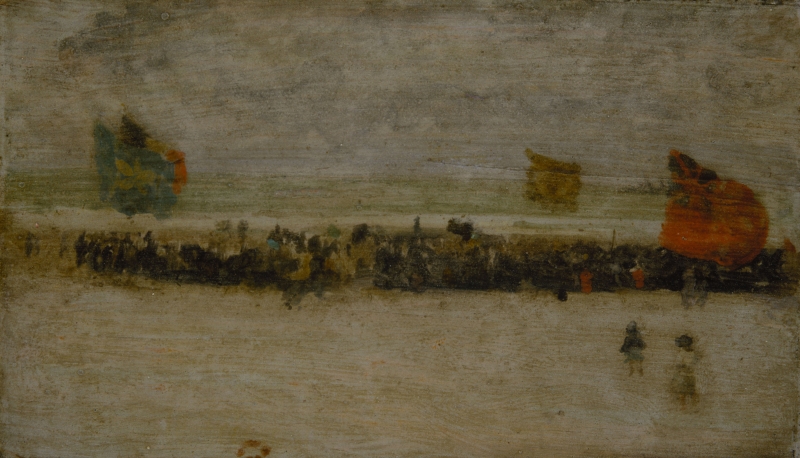Home > Catalogue > Browse > A Red Note: Fête on the Sands, Ostend << >>
Provenance
- 1890: sold by the artist to Edward William Hooper (1839-1901), Boston;
- 1901: bequeathed to Ellen Sturgis Hooper (Mrs John B. Potter) (1872-1974);
- 1974: bequeathed to her daughter, Mary Frances Potter (Mrs John Butler Swann) (1911-1989), Stockbridge, MA;
- After 1980: sold to a private collector.
- 1980/1983: Davis & Langdale Company, Inc., New York;
- 1983: Daniel J. Terra (1911-1996) (Daniel J. Terra Collection);
- 1992: Terra Foundation for the Arts Collection, Chicago.
According to Mrs John Briggs Potter (née Ellen S. Hooper) when Whistler was painting her portrait in 1890 (Portrait of Ellen Sturgis Hooper [YMSM 391]) he dug this painting out of a trunk and sold it to her father, E. W. Hooper. On 19 September 1890 Beatrice Whistler wrote to Hooper that Whistler wanted 100 guineas for 'Fête on the sands' which was 'a great pet of his' and was then in Brussels. 1 Hooper agreed, sent the cheque on 7 October, and acknowledged receipt of the painting on 13 January 1891. 2 It was lent for some years to the Museum of Fine Arts, Boston, and bequeathed by Hooper to his daughter Ellen, who lent it to the Whistler Memorial exhibition in Boston in 1904 (cat. no. 2) and to the Museum of Fine Arts in September of the same year.
Exhibitions
- 1887: 64th Annual Exhibition, Royal Society of British Artists, London, 1887 (cat. no. 277) as 'A Red Note: Fête on the Sands, Ostend', at £126.
- 1888: Exposition Brown, Boudin, Caillebotte, Lepine, Morisot, Pissarro, Renoir, Sisley, Whistler, Galerie Durand-Ruel, Paris, 1888 (cat. no. 43) as 'Note rouge – La Plage d'Ostende'.
- 1889: “Notes” – “Harmonies” – “Nocturnes”, H. Wunderlich & Co., New York, 1889 (cat. no. 40).
- 1890: Exposition Générale des Beaux-Arts, Brussels, 1890 (cat. no. 842) as 'Ostende'.
- 1904: Oil Paintings, Water Colors, Pastels and Drawings: Memorial Exhibition of the Works of Mr. J. McNeill Whistler, Copley Society, Boston, 1904 (cat. no. 2) as 'The Fete on the Sands – Ostend'.
At the RBA in 1887 it was priced at £126.0.0, and at Wunderlich's in 1889, the same (120 gns). 3
It was described in 1887 by the Manchester Courier as 'A Fête on the Sands at Ostend by Night' and by the Leeds Mercury as 'a group of flâneurs on the sands at Ostend, some of whom are sheltered by red parasols', and, in 1889, more accurately, in the New York Sun as ‘a dark grey day on the sands at Ostend with a fete in progress, and strong-coloured flags set against the heavy sky.' 4 Any difficulty in identifying the details was clearly in the eyes of the critics. George Bernard Shaw (1856-1950) thought it 'the most exquisitely truthful achievement in Suffolk Street.' 5
The Building News had described the painting in 1887 as 'an impression merely, and those who can see the poetry of faint impressions of light and shadow will find something in it.' 6 It is indeed one of the most 'Impressionist' of Whistler's paintings. In this context it is worth noting that the RBA exhibition of 1887-1888, in which it was exhibited, was notable for the inclusion of a substantial number of works by Claude Oscar Monet (1840-1926).
The Terra website discusses the significance of the early exhibitions:
'On his frequent visits to Paris from his home in London, Whistler often passed through Ostend, a popular seaside resort with regular steamer service to Dover, England. In the autumn of 1887, the artist was making a sketching tour of Holland and Belgium with his brother and sister-in-law, Dr. and Mrs. William Whistler. Early the following year, Whistler showed A Red Note: Fête on the Sands, Ostend in the annual exhibition of the Royal Society of British Artists, of which he was then president. His leadership of this conservative organization was controversial not only because of the reforms he autocratically pursued, but because of his advocacy of avant-garde art in its exhibitions. The 1888 annual included a number of works by French painter Claude Monet (1840–1926), Whistler’s longtime friend and a leader of the radical movement known as impressionism, the capturing of the instantaneous effects of contemporary subjects in bright, undiluted color applied in broken brushstrokes. Whistler’s own ideal of painting as the orchestration of poetic effects achieved through the manipulation of such formal values as color, line, and composition differed from the dispassionately scientific approach of some impressionists. However, Whistler’s and Monet’s common challenge to artistic conventions, according to which painting is an illusionistic window onto imagined, idealized three-dimensional reality, laid the foundation for the development of modernism at the turn of the century. With rapid, on-site execution and expressive, reductive evocation of a transient moment, A Red Note: Fête on the Sands, Ostend has been cited as one of Whistler’s paintings that most clearly reveals his sympathy with Monet’s impressionism. Evidence indicates that it was also one of Whistler’s favorite works.' 7
Whistler had hoped it might be lent to the World's Columbian Exposition, Department of Fine Arts, Chicago, 1893, but this did not happen. 8
Notes:
1: 19 September 1890, GUW #02165.
3: G. Dieterlen to Whistler, 1 November 1889, GUW #07187.
4: Manchester Courier, Manchester, 30 November 1887; Leeds Mercury, Leeds, 10 December 1887; Sun, New York, 10 March 1889.
5: Weintraub, Stanley, Bernard Shaw on the London art scene, 1885-1950, Pennsylvania State University Press, 1989, p. 193.
6: Press cuttings in GUL Whistler PC 9, pp. 22, 23, 36; PC 10, p. 87.
7: Terra Foundation for American Art website at http://collection.terraamericanart.org.
8: B. Whistler to E. G. Kennedy, [22 October / November 1892], GUW #09703.
Last updated: 31st March 2021 by Margaret





